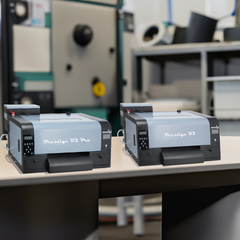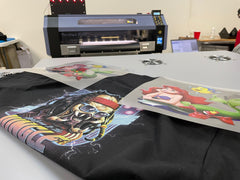by Richard Greaves ASPT - Lawson Screen Products
Fig. 1 Courtesy of Autotype Americas
Capillary film is direct emulsion coated at the factory onto rolls of ultra smooth clear polyester film. The factory dries and re-coats the film until the desired thickness is achieved. They have very special equipment to dry the film so there is only enough moisture to keep it from breaking when it ships. No screen maker can make a stencil, as smooth as capillary films because they coat on the very irregular surface of meshes, not the smooth face of polyester film.
Capillary film is desirable because you don't have to wait until the screen is dry like you do with liquid emulsion, you always have a super smooth surface, always the same thickness, ready to expose stencil in less than 30 minutes.

Silk screen stencil thickness is directly related to mesh count. As the mesh count increases so should your stencil thickness. Capillary films are drawn into the mesh as the film absorbs the water in the mesh. A thick film should be used on coarse mesh or the stencil will be too thin and it won't be very durable.
| Ulano CD Film | Mesh Count |
| CDF-10 | 419+ |
| CDF-15 | 419+ |
| CDF-2/UV | 305-419 |
| CDF-3 | 230-419 |
| CDF-4 | 196-305 |
| CDF-5 | 109-196 |
| CDF-7 | 76-140 |
Fig. 2
Degrease Silk Screen Mesh
New mesh usually has oil residue from its manufacture and reclaimed screens have residue from the chemical that breaks down the stencil. Degreasing is even more critical with capillary film (probably the most important step) than direct emulsion. Use a degreaser designed for screen making to scrub and rinse the mesh. Don't use household cleansers because they leave a sweet smelling residue or can leave chunks of abrasive wedged in the mesh fibers that will cause trouble later on. If you see foam as you scrub, you know the degreaser has completely cleaned that part of the screen. After you have thoroughly rinsed the screens with water, you don't have to let them dry, you can put the film on immediately.
Screen Printing Coating Room

Your silk screen mesh coating room should be as clean as possible and have UV (ultra-violet) safe lights. If you coat under normal lights you can pre-expose the screen printing stencil making it impossible to washout. Most screen printing emulsion manufacturers recommend gold or yellow fluorescent lamps, or you can buy sleeves that go around fluorescent tubes that filter UV light. Photo-polymer emulsion is still susceptible to yellow light, so keep the coating and drying room as dark as possible.
Apply capillary film in a sink, and not in the screen drying area. The best results will come from a back lit sink that has a holder in the bottom to keep the screen from moving. Keep in mind that light can expose the silk screen stencil where you coat the screen, during the walk to the area where you dry the screen, and where you store the screens.
In many ways application is quite simple, but you have to have all your components together at the same time so the capillary film rolls on the mesh screen like a perfect golf stroke.
You will need dry, lint-free rags, a soft window squeegee, and a small clean table next to the sink to keep the capillary film close at hand.
How the Capillary Film Sticks
The principle behind capillary film is to barely wet the surface of the film so it sticks to the mesh. When wetm the mesh and the film (capillary action) absorbs that water and the film softens, and sticks to the mesh. Think of a postage stamp that sticks when you get it wet, only you wet the envelope and that moisture wets the stamp, which makes it, stick.
We pour water on the mesh (spray tends to shoot through the mesh), and the natural surface tension between the water and mesh holds a certain amount of water in each opening for a short time before it drains away. Each thickness of capillary film has been designed to be wetted with the amount of water held by the mesh. Each capillary film manufacturer has a chart that shows the range of mesh counts it works best with.

Some people dislike rolls of capillary film because it forms a curl in the tube it is shipped in. Every time you want to cut a piece of film you have to take the film out of the tube, then roll it up to put back in. Cutting the curly film can be frustrating. Consider ordering stock, or custom size sheets that are perfectly cut, flat, and clean. Capillary film companies charge by the square inch for sheets, but you may have to order a few weeks in advance if you want a special size sheet.
Applying the Screen Printing Film

Fill up a large plastic cup, pitcher or container, with water. POUR this water down the mesh so the open area of the mesh fills and holds as much water as it can. You will see a very slight ripple across the surface as excess water drains down the mesh. The rippling stops when your mesh is holding as much water as it can. When the rippling stops you enter a critical time of about 10 seconds where the mesh surface tension holds the maximum amount of water in the mesh openings. When you stop pouring water, you must quickly drop the cup, dry your hands and grab a sheet of capillary film. Remember that the dull side (not the shiny side) is the coating. Count to 10 out loud when you see the rippling stop. If you don't start applying the film before you count to ten, put the film down and re-wet the screen again, then proceed.
Larger sheets will need to be rolled up. Pre-roll the sheets before you start applying and hold them with paper clips until you are ready to unroll. Press the leading edge against the wet mesh and when it sticks - gently let the sheet un-coil in your hands as you move them down. You will feel a slight tug on roll as the water attracts the capillary film. For very large sheets it helps to use a plastic or cardboard tube to support the film as you roll it down (like a paper towel core).
Small sheets can be applied by holding the top and bottom of the sheet in a 'U' shape, gently place the center of the dull side of the film against the wet mesh and softly roll the film onto the mesh. You will 'feel' the wet mesh pull the film down to the mesh. Quickly grab a dry rag and wipe up any water that might drip on the film and dissolve the stencil. Use a soft window squeegee, NOT a screen printing squeegee because it is too stiff, on the inside of the screen to remove any excess water. Blot all excess water and tears of emulsion with the dry rag. Don't use the squeegee on the stencil (bottom) side of the screen because it will push the stencil through the mesh like a hard-boiled egg through an egg slicer.
The Screen Drying Process
 Put the coated screen in a drying cabinet, horizontally, with the printing side down so the wetted surface of the capillary film can evaporate up. If you dry the screen with the polyester backing film up, the water won't evaporate up through the dry stencil and then get stopped by the polyester film.
Put the coated screen in a drying cabinet, horizontally, with the printing side down so the wetted surface of the capillary film can evaporate up. If you dry the screen with the polyester backing film up, the water won't evaporate up through the dry stencil and then get stopped by the polyester film.
If you use a dehumidifier in your coating room your entire room is a drying cabinet. Dry air will always speed drying more than hot air or fans. Use a relative humidity (Rh) gauge in the room to monitor how the Rh will rise as the screens dry and moisture fills the air - and how the Rh goes down as the dehumidifier dries the air.
Since the only water that needs to dry is the minimal water applied to the mesh, the screen dries quickly in a dry box. Monitor your stencil surface with an Rz meter or an inexpensive 30x microscope. In less than 30 minutes from when you degreased, you will know when the silk screen stencil is dry when the backing sheet pulls off easily with very little sound (no tug or crackling sound). Remember to pull off the backing sheet before you tape a positive to the stencil for exposure.






